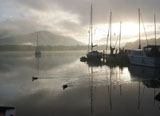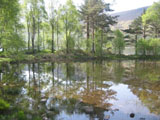|
|
Lake District Mountain and Fell Walks
7 High StileDistance: 9 miles (14.5km)
When viewed from Buttermere the High Stile
range rises like a wall of rock towards the sky, wooded at the foot and
streaming with becks pouring from a series of high corries. Direct ascents
look steep, rough and tough - and indeed they are. There is a route to Red
Pike which climbs uphill via Scale Force, and this has rather more
acceptable gradients. The ridge can be walked from Red Pike to High Stile
and High Crag, with knobbly Hay Stacks as an optional extra.
There should be no problem identifying the
line of the ridge walk to High Stile. The way is well trodden and
additionally marked by the remains of a former fence. Views down into the
steep-sided corrie of Bleaberry Cove include the lovely little Bleaberry
Tarn. Locating the highest part of High Stile takes a bit of elementary
surveying, as there are a number of cairns scattered across its broad and
knobbly top. The highest stands at 2,644 ft / 806 m. 8 Coniston FellsThere are dozens of ways to arrange walks around the Coniston Fells, as there are so many ways up and down, so many summits to include or exclude, and so many other points of interest such as mining, quarrying, rock climbing, etc. The route offered here is a circuit taking in the main crest of the range, but also offering splendid views of Dow Crag, and hinting at the wealth of industrial heritage in the form of quarries and copper mines. With extra effort, the fells of Dow Crag, Grey Friar and Wetherlam could be added to the round.
Distance: 8 Miles (13 km) Motorists can get a bit of a leg-up to the start of this walk by driving up the narrow Walna Scar Road from the Sun Inn in Coniston. Anyone arriving by bus will have to walk up the road. Cars can be parked beyond the fell gate in a small quarry just after the tarmac expires. It is important to close the fell gate securely to prevent sheep wandering down into Coniston. The Walna Scar Road continues as a rough surfaced track around the southern slopes of Coniston Old Man. Walkers can get into their stride by following this clear track, preparing themselves for tougher fell walking further along. There is another track heading off steeply uphill to the right, but avoid this as it ends in a working slate quarry which is both dangerous and forbidden to walkers. The Walna Scar Road continues around the flanks of Coniston Old Man, and after wet weather one stretch can be deep underwater. Further along, the track narrows, becomes quite stony, and is sometimes confined to cuttings in the bedrock. As it climbs uphill, keep an eye peeled to spot a large heap of stones, where another path heads off to the right. If a bridge with railings is reached, then steps will have to be retraced slightly to search for the path. The path climbs up alongside a broad and boggy valley, then climbs more steeply amid boulders and outcrops of rock. The immense, frowning face of Dow Crag assures walkers that they are on the right course, but timid walkers may find the prospect daunting. After climbing over a brow of rock the little tarn of Goat's Water is found couched in a wild hollow at the foot of Dow Crag's bouldery screes. It was on Dow Crag that pioneers of Lakeland rock-climbing practised, and names such as Haskett-Smith, Slingsby and Hopkinson are forever associated with these buttresses and gullies. The five big buttresses are known among rock-climbers as A, B, C, D & E. Routes such as Easy Gully and Easy Terrace are beyond the scope of many fell walkers, who prefer to use their hands only in extremes! Follow the path along the bouldery shore of Goat's Water, then climb out of the rocky dale-head using the path which is blazed up to the gap between Dow Crag and the Old Man. Parts of this path are quite badly worn, so walk with due care and consideration. It is as well to pause on the gap to regain breath and if the day is misty then it would also be sensible to make a careful study of the map before proceeding further. The Coniston Fells are covered by a network of paths and it is essential that walkers remain alert and never blithely assume that the path they are following is the path they should be following! There is a path climbing eastwards from the top of the gap, and it gradually swings south-eastwards as it crosses the rather featureless back slopes of the Old Man. By keeping to the right there should be no problem joining the path which has been trodden along the main crest of the fell, ending suddenly at the huge platform cairn which crowns the summit. There is a trig point nearby, but the extra height of the platform cairn brings the top of Coniston Old Man to an altitude of 2,633 ft / 803 m. Views have a great sense of depth as the slopes fall away to Coniston and Coniston Water without other heights to challenge the Old Man. Morecambe Bay, the distant Pennines and North Wales could be featured. Only in the opposite direction are any notable Lakeland fells to be observed, and they are crowded around the skyline from west to north to east. Although the crest of the Coniston Fells tends to dominate, this changes later on in the walk. Retrace steps for a short way along the crest of the fell, being careful not to be drawn back down the path towards Dow Crag. The narrow ridge used on this descent offers fine views down onto the blue-green tarn of Low Water, then the crest of the fells broadens considerably as it climbs gently, so that Brim Fell appears more like a football pitch than a fell. A small heap of stones graces its summit at 2,611 ft / 795 m. The path continues northwards, and the broad crest becomes a narrow ridge as it leads downhill. The next gap is Levers Hause, where walkers stand perched between Levers Water and Seathwaite Tarn. The next steep climb uphill reaches a break of slope at the top of Great How Crags. In mist, it is important to recognise this fact. Some walkers assume that they are on Swirl How, and are then led to make a dangerous descent along what they assume is Prison Band. Keep an eye on the map and continue northwards along the broad ridge to reach the true summit of Swirl Fell, which is crowned by a large cairn at 2,630ft / 802m. Views around the Lakeland Fells are considerably enhanced, and the view through to Langdale is particularly good. As from the Old Man earlier, every notable range of fells is in view, but from this airy perch more of their flanks can be seen. More distantly, in clear weather, the view can embrace everything from the Isle of Man to the Pennines. Descend eastwards from Swirl How's summit down the rocky ridge of Prison Band. Although this is steep and rugged for most of the descent, it also bears a clear path leading down on to a prominent gap, and provided that this path is used, there should be no difficulty. Once the gap is reached, turn right and follow a clear path down across the flanks of Black Sails. This path lands beside the shores of Levers Water. Continue to the outflowing stream, where there is an artificial dam, and cross to the far side. (Walkers who are aiming to catch a bus in Coniston might prefer to continue down through the Coppermines Valley in preference to the rest of the route described below.) Climb uphill from the ouflow of Levers Water, passing a huge funnel of a hole which is one of several entrances to a honeycomb of underground copper mines. Tread warily on this particular patch of fellside, and do not go near any holes. Cross over a little gap in the fells, then follow a path down into an area known as Boulder Valley. The reason for this name will be obvious, and after crossing a wooden bridge over a stream the enormous Pudding Stone can be inspected. Looking up towards Coniston Old Man, slate quarries and ruined inclines are stacked one on top of another practically to the summit of the fell. Looking down into the Coppermines Valley, the spoil heaps and ruins of the mining industry can be seen. The area is an absorbing study for anyone interested in industrial heritage. Follow a clear path and track which contours out of Boulder Valley reaching a slatey track used as a line of ascent to Coniston Old Man. Turn left to walk down this only a short way, then turn right to follow another clear track over a little gap in between the Old Man and the rugged hump known as The Bell. This track leads straight across the lower slopes of the Old Man to return walkers to the car park by the fell gate on the Walna Scar Road.
|
|



